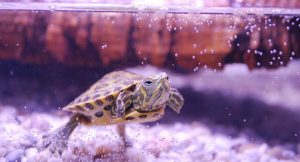Do turtles change colors? If you are one of those keen people, you will wonder and ask this question… Some people are very observant when it comes to details. I am not that observant, but I did notice my turtle color change.
I took a pic of my turtle while it was still small and a year later I took another picture of the turtle. When I compared the two pics, I could see some differences starting from the color.
This made me wonder whether turtles do change colors as they grow. To Increase my knowledge of turtles, I dived into research. Stay tuned to know more about turtles color change.
Table of Contents
Do Turtles Change Color?
Well, the answer is yes. Turtles do change color depending on a few factors. These factors include adaptation to the environment, seasonal changes, and camouflage reasons. All these factors are essential to the turtle. They are all about survival of the turtle. All turtle species are different including the way they change their color.
In this article, we will dive more into these factors and see how they affect the color change of turtles. I will also give examples of the different turtles with their color changes. Let us now begin by what causes the various shells and skin colors of turtles.
What Causes The Different Shell And Skin Colors Of Turtles?
What color is a turtle shell? Generally, a turtle shell has brightly colored scutes and a basal color that is grey to dark brown. From my research, I found out that different turtles have different colors and shell patterns. Baby turtles have different colors compared to adult turtles. As the baby turtles grow, their color changes to help them adapt to the different life stages. Another reason for their change in skin color is the environment they live in. Generally, most animals change their color depending on the environment they are in. Mostly, this is to help them camouflage with the environment. Take, for instance, the chameleon. They blend in with the environment to make it hard to be spotted by an enemy. This is also the case for turtles. They change their color to blend in with the environment. That way it will be hard for predators to see them. Another color change that is not healthy is caused by turtle shell rot. When the shell is rotten, it will lose the original color.
Is There A Reason For The Patterns On The Shell Of A Turtle?

From my understanding, it is these patterns on the shell of a turtle that make it possible for the turtles to camouflage. Water turtles will have patterns that will look like water ripples when in water or the water surface to prevent the birds from looking for food from spotting them. An excellent example of this is the Cooter turtle. Under the sea, some turtles have colorful patterns that resemble the undersea. A good example of this is the red-eared sliders.
The mauremys rivulata also have a dark green or dark brown color to help them blend with mud where they usually hide. The patterns also help with their appearance. Most people are attracted by the colorful appearance of some turtles. This is what drives them to get these turtles as their pets. These different patterns and colors of the shell also act as identification of the turtles. Turtles are identified by their colors and patterns.
Do Turtles Change Colors As They Grow?

Yes. The turtle’s color changes as they grow. Like I said earlier, this is to help them adapt to the various conditions. Their growth develops pigmentation and reflections on its shell. Their eyes, as well as the skin, also change color as they grow. A good example to demonstrate this is to take an example of a baby turtle. At this age, they cannot defend themselves from predators. They, therefore, have colors that will camouflage to prevent being seen or a color that will scare away the predator. Most of the turtle colors that scare away predators are yellow, red, black, and white. These colors give the turtles a threatening appearance.
Do Turtles Change Colors With The Seasons?
Among the things the turtles care mostly about, is mating. When the mating season comes, the turtles react in ways that make them more attractive to attract the opposite sex. One of these ways includes changing their color. Generally, turtles are attracted to bright colors. For this reason, some of the turtles will brighten their colors to attract females. The colors that are very attractive to turtles are red, yellow, and orange.
Example
An example is the male painted terrapin that changes color from orange to red or grey to white. Although this is the case, some other turtles that do change color but only the other turtles can notice. The change is almost unnoticeable. It is known that turtles can perceive more colors compared to humans. I think this is the reason behind this unnoticeable color change.
What Color Are The Eyes Of A Turtle?

Different turtles have different eye colors. You can even find some differences in the colors of the eyes of the same turtle species. Most of the female turtles have brownish-yellow to brown color. Most males have a red color. Some will have an orange color, but the most common is red. Some turtles like the Cooter have green and yellow eye color. The ornate box turtles have green eyes also. The central American wood turtle has bright blue eyes. All these are possible eye colors that different turtles do have.
Can Turtles From A Single Species Have Different Colors?
It is not uncommon to see the same species of a turtle having different colors. The reason behind this is that different turtle species may have subspecies. A good example of this is the slider species. This turtle species is divided into three subspecies. The red-eared slider, the Cumberland slider turtle, and the yellow-bellied slider turtle. All of these have different colors. The box turtle also has some subspecies. They include the western box turtle, Chinese box turtle, gold coin box turtle and more. Other turtle species also have sub-species. All these have different patterns and different colors.
Do Albino Turtles Exist?

Although the albino turtles are very rare, it is not uncommon to come across one. These turtles are rare because they rarely survive in the wild. This is because most of them do not survive coming out of the nest. If the do, they are not well suited to survive in their new environment. They have some abnormalities. This condition in turtles occurs due to the absence of pigmentation. This results in the white skin and the white shell. Since reptiles have at least two pigments, they will remain with some reddish or yellow pigmentation. When you notice your turtle shell turning white when he is big, it is not albinism. It is lack of UV radiation. Ensure that he receives enough UVB light. This is the reason why your turtle is losing color
Conclusion
Just as a recap. Answering the question do turtles change colors? We have seen that turtles do change color for some reason. Mostly, the reason behind their changing color is to adapt to different surroundings. They help the turtles to camouflage and prevent the turtles from being seen by the predators. Their color change is also beneficial during the mating season. The males change their color to a more bright color easily visible to the opposite sex. The bright colors are attractive to female turtles.



![You are currently viewing Do Turtles Change Colors? [Detailed Guide with Pictures]](https://turtlepets.com/wp-content/uploads/2019/11/Do-Turtles-Change-Colors-e1574332599115.jpg)

